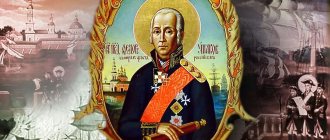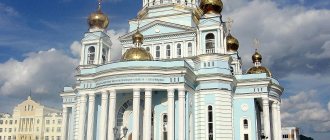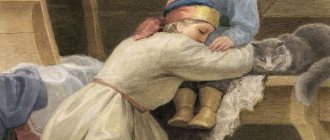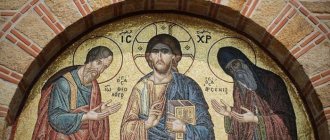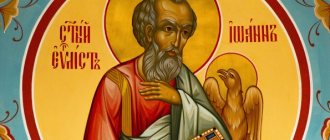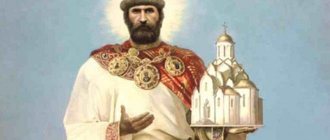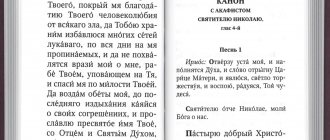| St. King Stefan Vladislav. Fresco of the Mileshevsky Monastery. |
Stefan Vladislav
(+ after 1267 [1]), King of Serbia, saint. Memory 24 September
Second son of the Venerable King Stephen the First-Crown. At one time he ruled the Black Wall municipality and at that time, in 1218-1219, he built the Mileshevsky Monastery in his lands.
When his brother Stefan Radoslav was expelled from Serbia, Vladislav was declared his successor. Radoslav announced his intention to return the throne, but the convictions of St. Sava of Serbia, their uncle, prevented civil strife. Taking the royal name Stefan, Vladislav ruled the Kingdom of Serbia from 1234 to 1243 [2].
Soon after his accession to the throne, Count Vladimir of Omysh and his people, accustomed to sea robbery, devastated the coastal lands of Serbia. Having dealt with the robbers with weapons, Vladislav obliged the residents of Dubrovnik with a letter not to help either Vladimir or others like him in actions hostile to Serbia.
Taking care of the internal structure of Serbia, King Vladislav found silver mines in the country, and by developing them he enriched the state. According to Daniel:
«
Wanting to reach the heavenly villages, he built beautiful temples on earth and supplied them with gifts (lands) and all sorts of accessories; From the foundation he built the Church of the Ascension of the Lord, called Mileshev, to which he transferred the body of the great bishop Savva from Ternov
«.
The king also generously did charity to the poor, the strange and the sick.
On the coins it was written: “ servant of Christ Vladislav
“, and was depicted as a standing king with a crown on his head, in long clothes, girded, with an orb in his right hand.
Even during the reign of Stefan, Vladislav negotiated for himself help and a safe stay in Dubrovnik if he was forced to leave Serbia. Subsequently, Vladislav was forced to cede the royal throne to his younger brother Urosh I, and he himself took advantage of this agreement and ruled Zeta. He died after 1267 and was buried in his heartland - the Mileshevsky Monastery.
The name Vladislav in the Saints
In the Orthodox church calendar there is only one day where this name is recorded - October 7 (September 24, old style).
Meaning of the name
The name has 2 bases: “Vlad” and “Slav”.
Hence its specific meaning is “to own glory.” An analogue existed among the ancient Germans - Valdemar. Perhaps its translation was borrowed by the Slavs and translated into their own language. This anthroponym is not originally Russian. He came from Serbia or Poland in the 13th century.
Secular diminutive noun forms: Vlad, Vladya, Vadya, Vladik, Slava.
This is interesting: among other peoples, Vladislav is pronounced as Ladislav, Ladislo, Vlaslo, Ladislao, Ladislau, Volodyslav, Uladzislau, Vlodzislav, Vladoslav, Ladislaus, Ladislas.
Main features
The meaning of the name simply obliges its bearer to have enormous willpower, perseverance and a flexible mind.
Character
Experts who study the influence of a name on a person believe that Vladislav, composed of 2 bases, forms the dual character of its bearer, making it difficult. It is difficult to know what a person who is “on his own mind” really feels. Outwardly, he may agree with his opponent while remaining consistent with his convictions. Only people close to him can find out his real opinion. Vlad has the following character traits:
- Self-esteem, decency, tact. A man will never be a hypocrite or fawn.
- Irony, the ability to joke. Because of his ridicule, Vladik can even be obnoxious.
- Persistence, hard work. Thanks to perseverance combined with intelligence, great opportunities arise to achieve success in career, business, and politics.
- Good nature. For help and support in difficult times, people of this name are loved and respected.
Duality of character also manifests itself in family life. There are 2 possible lines of behavior. After the wedding, a slightly different Vlad appears before his wife, who may disappoint. He doesn’t mind affairs on the side, but at the same time he becomes jealous, tormenting his wife with suspicion. The other, diametrically opposite Vladislav, is an exemplary family man, a homebody, a monogamous man, who does not even allow the thought of betrayal on anyone’s part.
Vladislav is a caring and loving father, whose authority is never questioned.
In Russia the name has a high rating. More than 90% of respondents consider it beautiful, sexy, modern, and brings good luck.
Saint Vladislav, King of Serbia
Article from volume 9 of the Orthodox Encyclopedia.
Vladislav [throne name - Vladislav Stefan] (c. 1200 - November 11 between 1264 and 1281), St. Serb. king (1234-1242) (mem. 24 September). Grandson of Stephen Nemanja (see Simeon the Myrrh-Streaming), 3rd son of Stephen the First-Crown (see Simon the Monk) from his marriage to Evdokia, daughter of the Byzantines. imp. Alexei III Angel. V. got married approx. 1234, probably for the 2nd time, on Beloslav, daughter of the Bulgarians. Tsar John Asen II. From this marriage he had sons Stefan and Desa, as well as a daughter, whose name has not been preserved, who was married to Prince. Churu Kacic, ruler of Omiš in the North. Dalmatia. Before his accession to the throne, V. was co-ruler of his elder brother Radoslav; they jointly confirmed the charter of Kotor in 1230. 4 years later, after the Battle of Klokotnitsa (1230), in the cut Bolg. The troops of John Asen II defeated the army of the Epirus emperor. Theodore Angel, whose daughter the cor. was married to. Radoslav, V., based on the Serb. nobles, overthrew his older brother, who had lost the support of his father-in-law, from the throne. Archbishop St. Savva I, not approving of these actions, but not seeing a way out of the situation, crowned V. and contributed to his marriage with the Bulgarian. princess - the daughter of the strongest sovereign in the Balkans at that time.
Serb. hagiographic sources (Life of St. Sava - see articles by Domentian, Theodosius Hilandarets) and later genealogies going back to them characterize V. in comparison with his brothers very positively (Naumov. The Dominant Class. pp. 242-243). With the blessing of St. Savva V. approx. 1234 began the construction and painting of his backdrop, the monastery-mausoleum of Mileshev. V. participated in the Church Council in Zich, in which St. Sava transferred the duties of the Head of the Serbian Church to his successor - Archbishop. Arseny I, and generously supplied St. Savva with funds for charity and distribution of alms during his trip to St. places.
After Radoslav was expelled from the country, V. concluded a peace treaty with Dubrovnik, and on July 23, 1237 with Split. V., just like Radoslav, titled himself “the thief of all Serbian and Pomeranian lands”; under him, the use of the title “autocrat” in relation to Serbs was first documented. sovereigns (it is possible that this title was used before) (Ostrogorski. Autokrator. P. 326, 327, 329; Naumov. The ruling class. P. 232-233); there is also information about V. being named king (Ibid., p. 242). V. issued a number of charters (chrisovuls) containing privileges and benefits (Ibid. pp. 115-119): the monastery of the Virgin Mary on Bistrica, founded by Stefan Nemanja, the island of Vranina on Lake Skadar (Shkodra). (1242) and probably Mont-ru Mileshev. In 1237, V. organized the transfer of the relics of St. from Tarnov to Milesheva. Savva. John Asen II wanted to leave the relics of the saint in his capital, V. had to personally persuade his father-in-law to return them to their homeland and accompany the transfer of the shrine. Obviously, V., along with the archbishop. Arseny was the initiator of writing the prologue Life of St. Savva and services for his dormition and transfer of relics (see: Trifunoviћ J. About dividing in Srbљaku // About Srbљaku: Studije. Beograd, 1970. P. 273-276).
In the last years of V.'s reign, his position in Primorye noticeably weakened, possibly as a result of the Mong. raid in 1241, but it cannot be ruled out that he could have ceded certain lands, trying to find an ally in the upcoming civil strife: since 1241, sources again mention him expelled from Zeta during the reign of Cor. Radoslav his cousin George Vukanović, first as prince in Ulcinj, and in 1242 as king. Soon after the death of John Asen II (1241), V., having lost the support of his father-in-law, was overthrown by his younger brother Urosh I, who gave him an inheritance while retaining the royal title of the south. part of the Serbian seaside possessions in Zeta with its capital in Shkoder. As an appanage co-ruler, V. played a significant role in the political life of the region, at least in Dalmatia: in the Bulgarian agreement. Tsar Michael II Asen, concluded with Dubrovnik in 1253 and directed against Serbia (see: Stojanoviћ J. Stari srpske poveje i pisma. Sremski Karlovtsi, 1934. Kњ. 1. Dio 2. pp. 206-207), V. appears along with Urosh as the main opponent. According to legend, V. died in the arms of his nephew Milutin.
V. was buried in the outer vestibule (entrance) of the Ascension Cathedral of the Mileshev monastery. The “manifestation” of V.’s relics occurred during the reign of Cor. Urosha V (1356-1371), the date of the event is known - June 30. According to the testimony of the Venetian traveler P. Contarini, dating back to 1580, V.’s tomb was located east of the shrine of St. Savva (Contarini P. Diario del viaggio da Venezia a Constantinopoli... nel 1580. Venezia, 1856. P. 19). In the messages of the Mileshevo monks to Moscow in 1587 and 1652. it is mentioned that V.’s relics are in the monastery (at present their location is unknown).
V.'s short life was written in the 2nd quarter. XIV century archbishop Daniel II and included in the hagiographic collection. "Lives of the Serbian kings and archbishops." V. services on Wed. century and early modern times apparently did not exist. The memory of V.'s death as a ktitor of the monastery is first found in the monthly parchment book of the Serbian. Apostle of the 1st third of the 14th century. (RNB. Gilf. No. 13; SKSRK, XIV. No. 12), brought by A.F. Gilferding in 1857 from the Mileshev monastery, starting in the middle. XIV century placed in a number of Serbs. lists of the Jerusalem Charter (Athos. Hilandar. No. 165. L. 45 - see: D. Bogdanov. Catalog of the Cyrillic manuscripts of the Hilandar manastir. Beograd, 1978. P. 98).
In Russia, the personality and deeds of V., primarily his participation in the transfer of the relics of St. Savva, became famous in the 1st quarter. XVI century thanks to the life of St. Savva, written by Theodosius (brought to Moscow from Athos in 1517), and the genealogy of the Serbs. rulers in the life of despot Stefan Lazarevich Konstantin Kostenechsky, which served as sources for the Russian Chronograph (1518-1522), and through it the Nikon Chronicle (PSRL. T. 10. P. 45-48; 1911. T. 22. Part 1. P. 392 -395). The veneration of V. in Russia as a saint began no earlier than the last. Thursday XVI century and is associated with fairly regular (mentioned in 1587, 1628, 1635, 1638, 1647, 1652, 1657, 1659, 1664, 1667, 1688) embassies for “alms” to Moscow of the monks of the Mileshev monastery (Russia’s relations with the East on affairs Church. Part 1. P. 187; Bantysh-Kamensky N. N. Registers of Greek Affairs of the Moscow Archive of the Collegium of Foreign Affairs (RGADA. F. 52. Op. 1). M., 2001. P. 52, 68 , 74, 92, 111, 114, 155, 198). Perhaps the veneration of V. was partly facilitated by his confusion with the homonymous Hung. king from the popular in Rus' “Tale of the Murder of Batu” (see art. Pachomius Logofet), according to legend, converted to Orthodoxy by St. Savva the Serbian. In 1751, the monks of the Athos monastery of St. Paul was brought to Russia by a stavrotek, made by order of V. (Leonid [Kavelin], archimandrite of the Slovenian-Srpska kizhitsa on St. Gori Atonskoy from the monastery Hilandar and St. Paul // Glasnik Srpskog uchenog drushtva. Beograd, 1877. Book 44. P. 270).
A lifetime portrait of the young V. was preserved in the paintings of the Ascension Cathedral of the Mileshev Monastery in the naos in the ktitor's composition with a model of the temple in his hands, accompanied by the Mother of God, in the inner vestibule, to the east. wall with his ancestors and brothers and, possibly, to the south. wall in royal vestments. V.’s lifetime image could also be on the stavrotek, made according to his order and equipped with the inscription: “And less than the sinful, unworthy servant of yours Stefan, who created and brought you this treasure with your mercy and help and the power of the honest Christian, stealing all the Russian lands and the Pomeranian lands of Vladislav save and have mercy” (Stojanoviћ. Records. Kњ. 3. P. 36. No. 4930); up to 2nd half. XIX century the relic was kept in the monastery of St. Paul on Mount Athos (its whereabouts are currently unknown). An early posthumous image of V. is found in the murals of the Arilye monastery (1296). The image of V. is included in the hagiodynastic composition “Nemanjic Vine” in the paintings of the vestibules of the cathedral churches in Gračanica (c. 1320), Pec (c. 1330), Decani (c. 1350) and Orahovica (1594). V. is depicted as a king in a jagged royal crown in the miniatures of the Laptev volume of the Facial Chronicle of the 70s. XVI century (RNB. F. IV. 233), in stories dedicated to the Serbian. history of the 13th century, as a saint - in an engraving in “Stematography” by Christopher Zhefarovich (Vienna, 1741. L. 5). A description of V.'s iconography is contained in the lists of Russian. Iconographic original, consolidated edition of the 18th century. under July 7: “... gray-haired, curly-haired in a royal crown, the brother of Athanasius of Alexandria, in purple, in his right hand a cross, and in his left a scroll: my soul magnifies the Lord and my spirit rejoices” (Bolshakov. Iconographic original. P. 113).
Literature: Markov V. Orthodox monasticism and manastir in medieval Srbiji. Sremski Karlovci, 1920. Gornji Milanovac, 2002. pp. 78-80; Ruvarats I. Krajitse and Tsarina Srpska // Zb. Ilarion Ruvaratsa: Odabrani ist. rejoice. Beograd, 1934. St. 1. P. 5-8; Moshin V. Poveja Krai Vladislava Theotokos Manastir at Bistritsa and the Golden Bule of the Krai Urosha // Glasnik Skopskog nauchn. Drushtva. Skope, 1940. T. 21; Pavloviћ L. Kultovi faces code of Srba and Macedonia: Historical-ethnogr. reprisal. Smederevo, 1965. P. 189; Ostrogorski G. Autokrator and Samodrzhats // aka. Sabrana's business. Beograd, 1970. Књ. 4. pp. 326-329; Radojchiћ S. Milesheva. Beograd, 1971. pp. 9-10, 20-21, 30, 32-33, 38-40; Naumov E. P. The ruling class and the state. power in Serbia XIII-XV centuries. M., 1975. S. 117-119, 226-229, 232-236, 238-243; Bogdanovi D. Brief life of St. Save // ZbMSKJ. 1976. Књ. 24. No. 1. P. 7, 14, 28-30; Bojović BI L'idéologie monarchique dans hagio-biographies dynastiques du moyen Âge serbe. R., 1995; Marjanoviћ-Dushaniћ S. Vladarska ideologiya Nemaњiћa: Diplomatika studio. Beograd, 1997.
A . A . Turilov
Saint Vyacheslav of Czech, commemoration date: March 17 (Transfer of Relics), October 11
He was raised by his grandmother, the holy princess Lyudmila, who from childhood instilled in her grandson faith in the Lord, trust in His will and the desire to always act according to the commandments that the Savior gave us. He received his education from a student of St. Methodius, Presbyter Paul.
In 920, Vyacheslav’s father, Vratislav, dies, and as an 18-year-old young man, the passion-bearer ascends to the princely throne. His life was darkened by the fact that Dragomir’s own mother hated Christianity; it was she who was responsible for the death of Vyacheslav’s grandmother, Saint Lyudmila. For this he banished Dragomira from his life forever.
In 935, the saint was killed by his brother and his guards right on the threshold of the temple. Subsequently, everyone who followed Prince Vyacheslav of Czech, who, like him, led a pious lifestyle, was subjected to cruel torture and torment. Nothing is known about the fate of his son Zbraslav.
Icon of the Holy Blessed Prince Vyacheslav of Czechia
First years of reign
The holy king Stefan-Wladislav became another noble branch on the glorious vine of the Nemanjić dynasty, which gave the world many holy men and devotees of piety. He lived during the years of formation and strengthening of Serbian statehood and was the second son of St. Stephen the First-Crown, the nephew of St. Sava, Archbishop of Serbia, and the grandson of the founder of the dynasty of Serbian rulers, Stefan Nemanja, known as St. Simeon the Myrrh-Streaming. Both the grandfather, the father, and the uncle of the blessed Vladislav achieved true holiness through their labors and deeds, receiving from the Lord imperishable crowns of glory.
Stefan Vladislav, Stefan Radoslav and Stefan the First-Crown Nemanjic After the blessed death of Stefan the First-Crown, Serbia was ruled by his eldest son Radoslav, who at first was a ruler worthy of all praise, but, according to the church writer Theodosius, gradually fell under the strong influence of his wife, from whose beauty he was damaged mind. The Serbian nobility was dissatisfied with the behavior of the ruler, and under their pressure Vladislav was forced to accept power. Enmity began between the brothers. Their uncle, Archbishop Savva, exhorted them to live in peace, but was unable to quickly reconcile them. Having lost power, Radoslav sought refuge in the city of Drace, but even there the beauty of his wife served as a source of trouble for him. Soon he was deprived of his malicious and crafty wife, who became for him, according to the same Theodosius, like Delilah for Sampson. Through her fault, the hatred of the local ruler Drach fell upon Radoslav, and he barely escaped death. Wanting to finally end the enmity between the brothers, Saint Sava adorned Radoslav with the angelic monastic rank, giving him the name John in monasticism. To finally end the unrest and strife, the archbishop crowned Vladislav with a royal crown. And soon, with the blessing of his uncle, Vladislav became related to the powerful Bulgarian Tsar John II Asen, taking his daughter Beloslava as his wife.
Vladislav's upcoming name day
How to correctly determine the spiritual patron and the name day of Vladislav according to the Orthodox calendar? Options you can consider:
Vladislav's name day in October
Traditionally, Christians named their children strictly according to the church charter, so there was no confusion between Name Day and Angel Day. Today, not everyone distinguishes between these two memorable dates.
Day of Angel Vladislav
- this is the day of his baptism. It is called so because after the Sacrament a Guardian Angel appears at the baptized person, who accompanies and protects the ward.
And the Name Day named after Vladislav
- This is the day of veneration of one of the saints named Vladislav.
Relics of Saint Sava
A year after the death of Sava, his worthy heir, Archbishop Arseny, turned to Vladislav, urging him to do everything possible to ensure that the remains of the saint were transferred to his homeland.
Church of the Holy Forty Martyrs of Sebaste.
Veliko Trnovo “It is not good and unworthy before God and before people,” said Saint Arseniy, “for us to leave our equal-to-the-apostles father, the teacher given to us by Christ, who accomplished many feats and worked hard for the Serbian country, adorning it with churches, royal power, and an archbishop. and bishops and all the institutions and laws of Orthodoxy, so that his holy relics lie outside the borders of his fatherland and the throne of his church, in a foreign land.
Saint Arsenios, Archbishop of Serbia
Inspired by the words of Arseny, Vladislav without delay sent worthy people to his father-in-law Asen with a request to give him the relics of the saint. Having received Vladislav’s letter and listened to the messengers, the Bulgarian king was very upset. He answered the Serbian ruler that if the saint’s body had been left without due honors, then his request would have been completely legal. But since it rests in the Church of God and is given no less honor than it would be in Serbia, he does not understand why Vladislav bothers the saint. With these words, the king sent the Serbian envoys home. Not satisfied with the answer he received, Vladislav again sent his nobles to the king with the words: “If I have found grace before you, my parent, then do not close your fatherly mercy before me and do not leave me, so that my life does not plunge into sadness. Give me the holy relics of my lord and father, so that I can transfer them to my fatherland!” King Asen was at a loss as to what to do, thinking that if he lost the saint, he would also lose his kingdom. Having called the Bulgarian Patriarch and his entourage, he turned to them for advice. Everyone unanimously assured him that under no circumstances should he give in to Vladislav’s requests: this would cause the indignation of the Bulgarian nobles and people. The king again wrote words of consolation to his son-in-law, adding: “If God wanted the saint to rest among us, the faithful in Christ, then who am I to resist the will of God or dare to disturb the grave or holy relics? For the saint really did not bequeath anything about his transfer. So, ask me for whatever you want... my son, but stop forcing me to give you what is not easy for me to give, for the patriarch, the nobility, and the whole city oppose me in this.” And again, having given gifts to the envoys, he sent them to Vladislav. Seeing such firmness of the Bulgarian king, Vladislav decided to personally go to Trnovo, and, taking with him quite noble people, bishops and abbots, he sent messengers ahead of him with gifts for the patriarch and royal advisers, notifying Asen of his imminent arrival. When Vladislav arrived in the Bulgarian land, Tsar Asen greeted him with love far from his capital. Arriving in Trnovo, Vladislav first went to the tomb of St. Sava. Arriving at the monastery, he, together with the bishops and nobles, rendered worthy worship to the saint of God. Having bowed to the saint’s tomb, Vladislav from the depths of his heart prayed to the saint, repenting of his sins and asking him not to reject his request, not to leave his fatherland, for which he had suffered countless deeds and labors. Having fervently prayed to the saint, Vladislav left the temple and went to the ceremonial reception prepared by the Bulgarian Tsar.
Bulgarian Tsar Ivan Asen II
That same night, an Angel of God in the form of a saint in a dream commanded the king to give the holy relics to be transferred to Serbia. Frightened by this phenomenon, the king called the patriarch and advisers and told about what he saw in his dream. After listening to him, they said that this visitation of God was through the prayer of the saint, and unanimously asked Asen to give the great shrine to King Vladislav, so as not to bring the wrath of God upon the Bulgarian kingdom and people. Asen called his son-in-law along with the Serbian bishops and nobles to inform him that he was ready to satisfy their cherished desire. Saddened, he turned to Vladislav with these words: “I wanted to have the saint in my monastery, as given to me by God, and I decorated and revered his holy grave, as you saw, without thinking that the saint would be taken away from us. But since you, Royal Highness, took the trouble to come to me, your father, I do not want to let you go saddened as my son. So, receive your father in the Lord and take him to your home according to your desire.” From such unexpected joy, King Vladislav, with his bishops and his noble people, fell to the ground and bowed to the king.
Hieromartyr Vyacheslav Lukanin, memorial date: February 8 (New Martyr), August 16
Almost ten centuries later, in the Russian state in the city of Perm, a boy will be born, whom his parents will also name Vyacheslav. He grew up very weak and sickly, and his studies were difficult for him.
Despite this, Vyacheslav Lukanin sought to enter a theological school; serving the Lord was his only desire, which was fulfilled over time. The Lord gifted him with a beautiful voice. This talent did not go unnoticed by the school teachers. Very often the young man served in the choir at the local church, they even began to call him “choir leader,” he did so well. He mastered other sciences with great difficulty, constantly retook exams, and devoted all his free time to church singing. In 1889, after graduating from college, he entered the Perm Seminary. But my health prevented me from getting my diploma.
On the eve of the bright feast of the Transfiguration of the Lord, the martyr Vyacheslav and some believers of this town gathered to discuss how best to conduct the festive Liturgy. The meeting was held in the evening in one of the houses, they lit candles, and a small ray became visible from behind the curtains on the side of the street, where at that time there was a curfew and punishers were patrolling the streets. The monsters broke into the house and arrested everyone who was there. In the morning, the believers were taken to the temple and ordered to dig their own graves.
Father Vyacheslav finally asked only to pray in the temple, starting to read the funeral prayer, he slowly walked towards the temple, at that moment the “Krasnoorlovets” shot him in the back.
Deacon Vyacheslav Lukanin was canonized in 2002.
Love for Uncle the High Hierarch
It is known that the pious Vladislav was obedient to his uncle and archbishop in everything, and was in peace and harmony with him. When Saint Sava decided to leave the high priestly throne and communicated his desire to Vladislav, he tearfully asked his uncle to change his decision, but could not restrain him. In 1233, Saint Sava gathered a council of Serbian bishops in Zhiche and, having announced his intention, chose from among his closest disciples his heir - blessed Arsenius, a man who was reverent in everything and kept the commandments of God with fear.
Saint Sava, Archbishop of Serbia. Milesheva Monastery Vladislav and the nobles were also present at the council, where the saint gave them instructions and commanded them to preserve and protect the holy churches. When Sava went to the Holy Land in the spring of 1234, Vladislav generously supplied him with gold and everything necessary for distributing alms in holy places. They were no longer destined to meet in this earthly life. Having visited holy places and made a considerable journey, Saint Sava departed to the Lord on the way back, not having reached his native Serbia quite a bit. This happened on January 14/27, 1236, when he was visiting the Bulgarian Tsar Asen after a long pilgrimage. After the funeral service performed by the Bulgarian Patriarch Joachim, the body of the saint was buried with great honors in the monastery church of the Forty Martyrs of Sebaste in Trnovo, built by the tsar.
